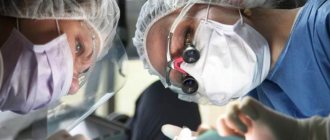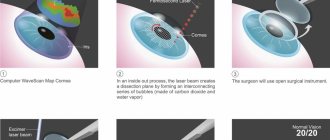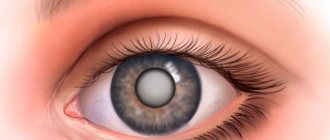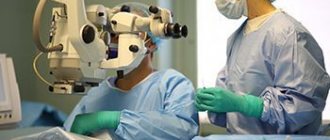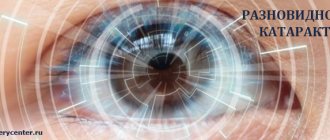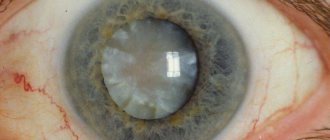Laser discillation is a procedure that aims to treat secondary cataracts after artificial lens surgery. What are its indications and are there any contraindications for its implementation? Details in our article.
In this article
- Causes of secondary cataracts
- Risks of manifestation of opacification of the posterior capsule of the lens
- Signs of a secondary anomaly
- Elimination of opacification of the posterior capsule of the lens in secondary cataracts
- Laser dissection of the posterior capsule for secondary cataracts - features
- Who is prescribed discision and to whom is it contraindicated?
Such a deviation as clouding of the posterior capsule of the lens of the eyeball leads to a significant deterioration in visual acuity. In modern ophthalmology, when removing a cataract, specialists leave a capsule into which an artificial lens is implanted. It is important to understand that secondary cataracts begin to progress not on the implanted lens, but on the remaining capsule. The anomaly is very common in patients in the postoperative period; according to statistics, it occurs in approximately 40% of patients 2-5 years after surgery.
Today, to eliminate the disease, the laser method of corepraxy of the posterior capsule of the lens is used - the formation of a new pupillary opening. This is a fairly quick, yet highly effective and low-traumatic procedure.
Causes of secondary cataracts
Research by scientists has not yet made it possible to establish the exact causes that contribute to the manifestation of this disease. During the development of opacification of the posterior capsule of the lens, active proliferation of the epithelium occurs, which is localized on its surface. Due to this, blurred vision occurs, the patient has difficulty distinguishing objects, as if looking through dirty contact lenses or glasses.
These processes are completely unrelated to the doctor’s error during the operation. The appearance of secondary cataracts is associated precisely with the body’s response at the cellular level, when the epithelium turns into functionally inferior fibers, irregularly shaped, losing their transparency. Cloudiness can also be caused by fibrosis of the capsule.
Features of the laser treatment method
During the operation, the specialist burns the necessary space for light to enter the lens capsule, which will restore vision. Outpatient and quick treatment of secondary cataracts with a laser is also a huge advantage, because it allows you not to waste time and not be greatly distracted from your usual pastime. Reviews about this testify to the truth:
Victoria, 59 years old: “Hello everyone! I'll start with the main thing! Due to the painlessness of the laser discision intervention for the disease, the procedure does not require anesthesia at all - which I was very happy about. The device itself ensures complete safety and selectivity in exposure, which eliminates the likelihood of injury. After 30 minutes, I could already see very well and did not observe any unpleasant symptoms. Thanks to this wonderful technology."
As for the cost, the price of the operation may vary depending on the prestige of the clinic and the location. So, the price in Fedorov’s clinic reaches rubles, but the price, for example, in such large cities as Moscow or St. Petersburg can be the same.
What laser is used for the operation?
Femto laser treatment of cataracts is carried out with the LensX laser system manufactured by Alcon (USA). The laser is designed for high-tech operations in ophthalmic surgery, equipped with a 3D monitor and an optical coherence tomograph with the ability to adapt the device to the visual system of each patient. The prefix “femto” means the ability to generate ultra-short pulses. During the operation, the doctor fully controls the depth and intensity of the laser beam.
Treatment of cataracts with femtoassistance is an intervention unprecedented in its safety and effectiveness, which has received well-deserved recognition from the world's luminaries of ophthalmology. The technique is successfully used in 50 countries around the world; clinical studies have proven the effectiveness of laser exposure in assessing the immediate and long-term results of femtoassistance in the treatment of cataracts.
Risks of manifestation of opacification of the posterior capsule of the lens
Experts identify several factors that may influence the progression of secondary pathology of the visual organs. Among them:
- The age category to which the person belongs. Thus, it has been established that in children after laser surgery the anomaly occurs much more often than in adults. This is explained by a higher level of tissue regeneration, which causes cellular migration of the epithelium. It is these processes that cause division in the capsule remaining after removal of the primary cataract.
- Shape of the intraocular lens (IOL). As practice shows, the square shape of such a lens gets along in the patient’s body much faster, which significantly reduces the risk of damage to the capsule.
- The material from which the IOL is made. Ophthalmologists emphasize that if the intraocular lens is made from a material with a high percentage of acrylic and is implanted into the posterior capsule of the lens, secondary cataracts occur much less frequently. Silicone IOLs, on the contrary, cause pathology quite often.
- Diabetes mellitus and a number of concomitant visual diseases.
Possible complications
Despite the lightness and absence of wound channels in the structure of the eye, complications are possible even after laser correction of secondary cataracts. Among the complications are:
- damage to the lens, the appearance of black spots before the eyes without reducing visual acuity;
- racemose retinal edema (possible with early secondary correction);
- retinal detachment;
- increase in intraocular pressure.
The risks of developing negative consequences are extremely small.
The professional approach and many years of experience of the staff of the clinic on Chernaya Rechka allow many patients to return to their former lives. The elementary procedure is available to everyone today. You can find out about the ophthalmology department of the OkoDent medical center on the website
Signs of a secondary anomaly
After the end of laser surgery to replace the lens, it is impossible to determine whether the disease has re-developed. The time period for the initial stage of development of opacification of the posterior capsule in secondary cataracts can range from 2 to 10 years. Only after this interval may obvious signs of eye disease and loss of objective vision appear. Thus, the clinical picture of the pathology varies significantly depending on the area of deformation of the lens; if this occurs in its periphery, vision deterioration may not be observed at all.
Clouding of the posterior capsule of the lens with the occurrence of secondary cataracts is most often detected during a routine examination by the attending ophthalmologist. If persistent visual impairment has been established, even if it was restored during laser surgery, treatment is prescribed. Also, a number of manifestations include the presence of a veil, halos and glare in poor lighting, double vision of the objects in question, distortion of color perception, and the development of myopia (myopia). Clouding of the posterior surface of the lens can appear on one or both visual organs.
The main signs of cataracts
- blurred vision;
- dazzling shine around objects;
- sensation of streaks, stripes and spots flickering before the eyes;
- difficulty reading and sewing.
In addition, as this disease progresses, the color of the pupil turns white instead of black.
As a rule, the appearance of cataracts is associated with age-related changes, but congenital cataracts also exist. Also, the development of the disease can be caused by the presence of the following endocrine disorders: diabetes mellitus, metabolic disorders, vitamin deficiency, etc. You should not “deprive” attention of hereditary predisposition, eye injuries, some eye diseases and unfavorable environmental conditions.
According to experts, cataracts can appear as a result of taking certain medications, especially hormonal drugs, which today are prescribed to treat most diseases (for example, arthritis and asthma).
Indications for laser dissection
Secondary cataract - a complication of surgery to remove the lens and replace it with an intraocular lens - is one of the main reasons for such an intervention. The degree of changes, subjective indicators of decreased visual acuity, and the stage of progression of the process are assessed.
Treatment of cataracts in this way is also used in other cases:
- special cases of lens opacification – fibrinous, membranous forms of the disease;
- development of secondary opacification of the lens capsule due to other operations;
- the presence of a tendency towards the development of fibrotic changes and the replacement of functional tissue of the organ of vision with connective tissue structures.
If we are talking about children, then at a younger age there are the following additional indications for prescribing laser dissection of secondary cataracts:
- development of strabismus;
- the formation of pathological neoplasms in the pupillary zone;
- obstacles to the normal passage of light rays through the optical media of the organ of vision;
- disturbance of gaze fixation.
Prices for IOLs implanted during surgery
| Name of intraocular lens | Country of Origin | IOL price (RUB, 1 piece) | |
| MZ60BD Silco | USA | 5 000 | |
| Hydro-Sense Aspheric Rumex Ltd | Great Britain | 9 000 | |
| Acrysof Multi-Piece Alcon | USA | 19 500 | |
| Acrysof Natural Alcon | USA | 19 500 | |
| Acrysof IQ Alcon | USA | 22 000 | |
| ZEISS CT ASPHINA 509 M | Germany | 23 500 | |
| Acrysof ReSTOR Alcon | USA | 48 000 | |
| Acrysof SND1T5 Restor Toric Alcon | USA | 70 000 | |
| ZEISS AT LISA 809 M | Germany | 51 000 | |
You can find out more information about the prices for cataract surgery and artificial lenses from the administrators of our ophthalmology center by calling the numbers listed on the website.
Elimination of opacification of the posterior capsule of the lens in secondary cataracts
Treatment of the pathology of the anomaly occurs with the help of capsulotomy - freeing the central optical zone of the visual system from clouding, which allows light rays to penetrate into the eye and increase visual acuity. Less commonly, this procedure is performed mechanically using special surgical instruments, often using a laser method. This is due to the fact that the latter procedure is practically non-traumatic and very fast, it lasts several minutes.
While surgical intervention involves excision/dissection of the clouded film. Most often, the hole diameter is 3 mm. The disadvantages of the surgical method are that subsequently infection of the eyes, swelling of the cornea, and hernia may occur if the integrity of the membrane is violated.
Stages of laser surgery
The technique of laser surgery is very simple.
- First, anesthesia is instilled into the patient's eyes.
- After this, the surgeon makes a micro-incision.
- Then a special tip is inserted into this incision, from which ultrasound comes. Using this device, the lens is removed from the eye. An artificial lens is placed in its place. It is very flexible and when folded, it unfolds and locks itself in place of the lens.
- After the operation, the surgeon seals the micro-incision without stitches.
And that’s it – vision is restored!
Check out the video animation about laser therapy:
Contraindications
- cicatricial or edematous changes in the cornea that obstruct the laser beam;
- decompensated glaucoma;
- increased vascularization (abundance of blood vessels) of the pupillary membrane;
- infectious and inflammatory process in the eye (is a contraindication to any, not just laser interventions).
In some complex cases where combined correction is necessary, a certain risk has to be taken even in the presence of relative contraindications, since in these cases laser discision still turns out to be more effective and safe compared to surgery.
Relative contraindications are considered to be: too short (less than six months) period after surgery, the presence of significant residual masses due to removal of the lens, initially increased intraocular pressure, retinal edema and some other clinical circumstances that force one to weigh the pros and cons with particular care.
Advantages of the method
Phacoemulsification using a femtolaser provides:
- Particularly high level of precision at all stages of the operation. Laser parameters are calculated down to the micron, the risk of errors is practically eliminated;
- Minimally invasive, gentle effect. The use of a femtolaser reduces the time of exposure to ultrasound, which is especially important in cases where there is a possibility of corneal edema after surgery;
- Fast recovery after surgery. The micro-approaches created by the laser are healed naturally in a short time, since the cornea is not cut by mechanical instruments.
- Maximum quality of vision. Implantation of an artificial lens is carried out after careful selection of the characteristics of the intraocular lens, ensuring complete elimination of visual dysfunction.
- Predictable long-term results. Automation of the most complex microsurgical procedures makes it possible to predict the effect of the operation with the highest accuracy.
- Minimal risk of postoperative astigmatism and other adverse effects.
Treatment of cataracts with femtolaser support is a godsend for those patients who have certain contraindications to surgical treatment with the traditional method (for example, thinning or dystrophy of the cornea, too low endothelial density, etc.).
Laser dissection of the posterior capsule for secondary cataracts - features
Removal of cloudiness from the posterior capsule of the lens is carried out using laser beams. This method is characterized by the highest degree of reliability, which is achieved by precise focusing and low energy consumption of the beams on average 1 mJ/pulse. This procedure with intervention with a laser device is called discision (cleansing) of the posterior capsule.
During this procedure, by burning in the back surface of the capsule, the specialist makes a hole through which the cloudiness is removed. The operation lasts only a few minutes, and if it is successful, the patient does not need to stay in the hospital for more than 1-2 hours. During the process, the patient will not experience pain or other discomfort; the specialist will first subject him to local anesthesia.
Laser dissection of the posterior capsule of the lens of a secondary cataract involves the following steps:
- The ophthalmologist applies special drops to the corneal surface of the visual organs that dilate the pupils and also prevent an increase in eye pressure;
- Several shots of laser beams are fired, which causes the appearance of a transparent window in the lens capsule, and the secondary cataract is eliminated.
After the procedure, the patient is not given any bandages. The rehabilitation period passes quite quickly (on average one month) and painlessly. During this time, the person needs to undergo several routine examinations, follow the instructions of the ophthalmologist and use the prescribed hormonal drops. Studies show that if all recommendations are followed, the risk of recurrent complications is very small, it is only 2%.
Progress of the operation
First of all, it is necessary to ensure the maximum possible and unobstructed optical access. For this purpose, before the operation, drops that dilate the pupil are instilled - these can be solutions of tropicamide, irifrin, midriacil in appropriate concentrations. If there is reason to fear that intraocular pressure will increase sharply after the procedure, an antiglaucomatous drug is also prescribed prophylactically.
The operation itself is performed “in one day”, hospitalization is not required, the patient independently leaves the clinic within 1.5-2.5 hours after the operation, if no complications are detected (statistics indicate that this probability is extremely low, almost Complications are always detected within the first hours or, at most, days). The procedure is very short, painless - in most cases, even local anesthesia is not required, not to mention stitches or bandages. Drops are prescribed for the immediate postoperative period to prevent inflammation. A follow-up visit to an ophthalmologist a week after surgery is mandatory, and a month later is advisable. Repeated laser dissection is rarely prescribed: as a rule, therapeutic success is achieved with a single procedure.
By contacting an ophthalmologist, you receive guarantees of an individual approach and highly qualified medical care in the diagnosis and treatment of secondary cataracts. Trust your vision to professionals!
Difference between ultrasound and laser cataract removal
All operations aimed at eliminating the “film” are reduced to crushing and removing the affected lens, followed by the installation of implants, which are intraocular lenses. The use of a laser in this area has made it possible to increase the effectiveness of the operation and minimize the risk of complications.
The incision made in the cornea closes itself, so no stitches are required. The patient can return home several hours after surgery.
Corneal incision
Manipulation is carried out using a diamond knife; it ensures maximum precision and accuracy of the cut. The femtosecond device creates a “notch” of an ideal shape. The cut must be straight, stretched or crooked will not maintain tightness and stability. In this case, the risk of complications increases.
Formation of capsulorhexis
The lens is housed in a special capsule, which is supported by numerous ligaments. To get the contents you need to cut the “packaging”. Using a surgical instrument, the doctor makes a small round hole in the capsule. The laser carries out a similar procedure several times faster and more accurately, which allows you to achieve perfect alignment.
The cut should be circular so that the tension force is distributed evenly over the entire surface and the capsule does not tear. It is almost impossible to carry out such filigree work manually; the hole turns out torn, so the tension force in the meridians is not uniform.
| This threatens in the future rupture of the capsule and, accordingly, further problems with vision. The laser helps to make an even cut, which eliminates the risk of complications. |
Lens destruction
During phacoemulsification, the doctor inserts the tip of an instrument into the damaged eye and crushes the lens using ultrasound. The laser creates flashes of energy in the thickness of the clouded mass, cutting the structure into microscopic cubes. They are sucked out of the cavity using a tip. In advanced situations, the doctor can simultaneously use laser and ultrasound, but sets a lower power so as not to harm other structures of the eye.
Reducing the force of the devices will help keep the corneal endothelial cells intact and avoid eye burns. Return to contents
Reasons for the development of pathology
Researchers cannot yet give a definite answer to this question. The epithelial cells of the posterior capsule begin to actively grow. At the same time, they take on an irregular shape, more reminiscent of fibers, and lose their inherent transparency. The patient begins to see objects around him as if through dirty or clouded glasses.
Secondary cataracts are not the result of medical error. In some cases, the development of pathology is triggered by fibrosis of the lens capsule, which remains in the eye after cataract removal.



